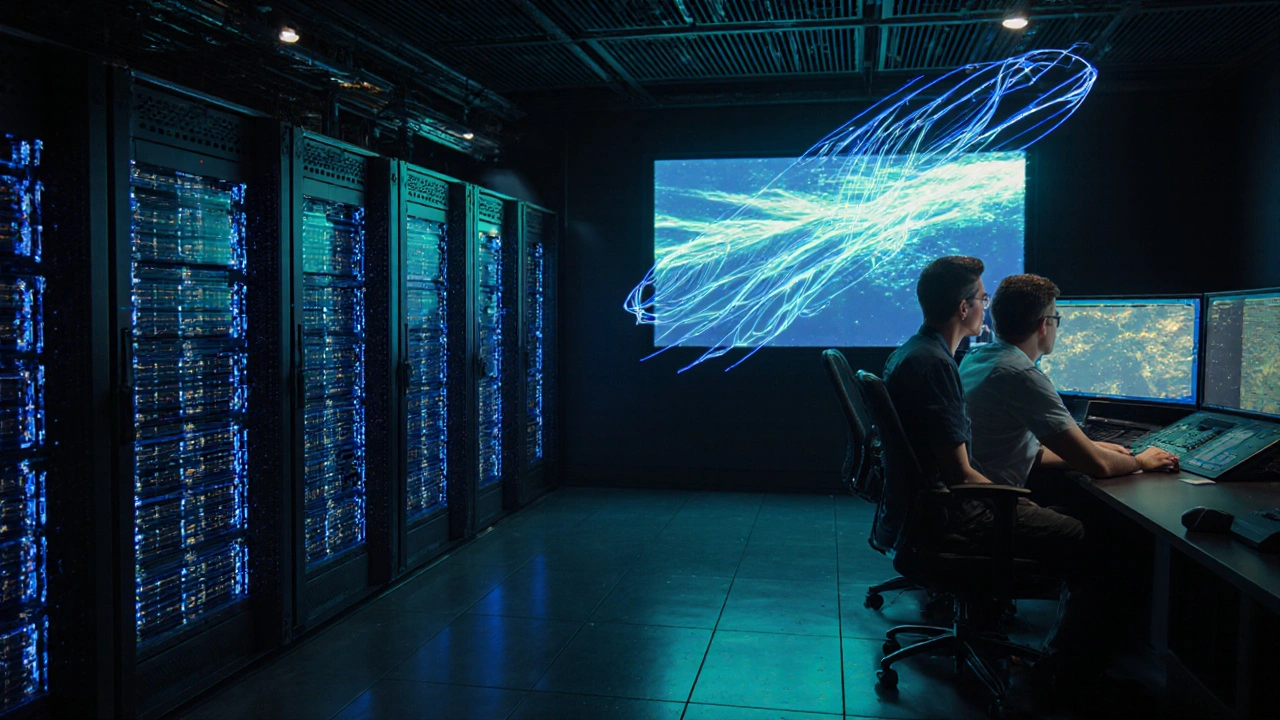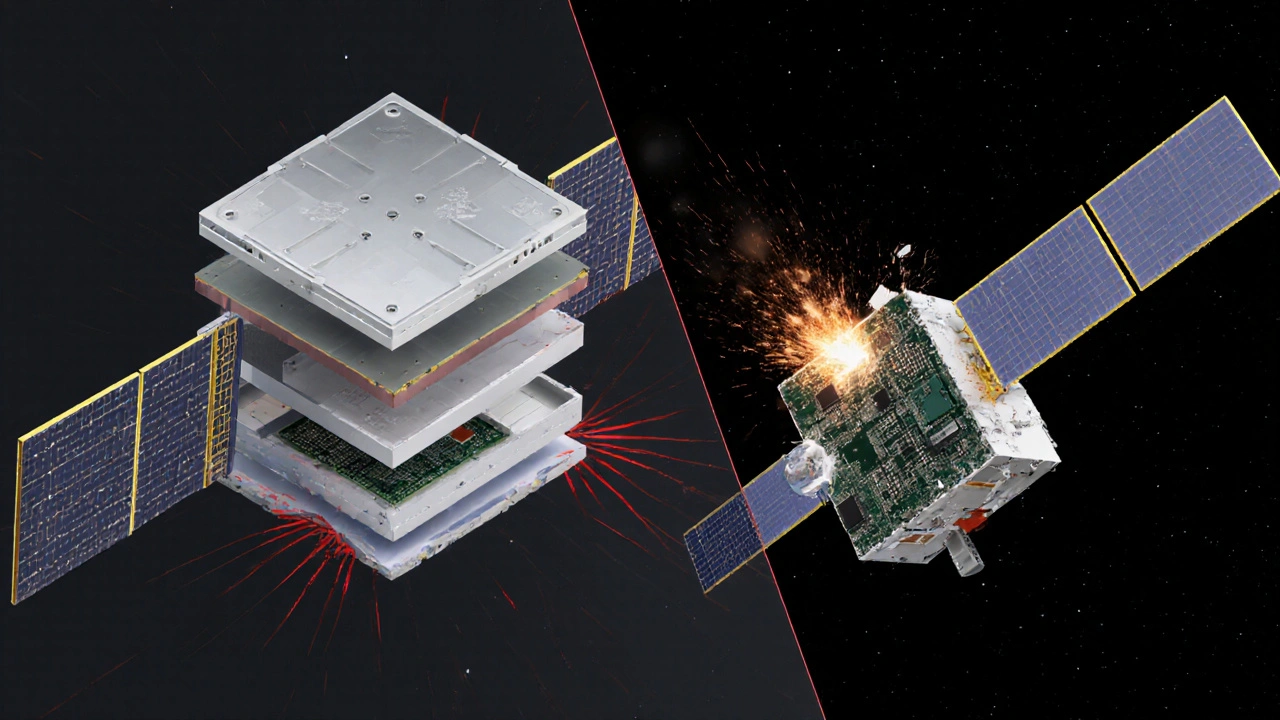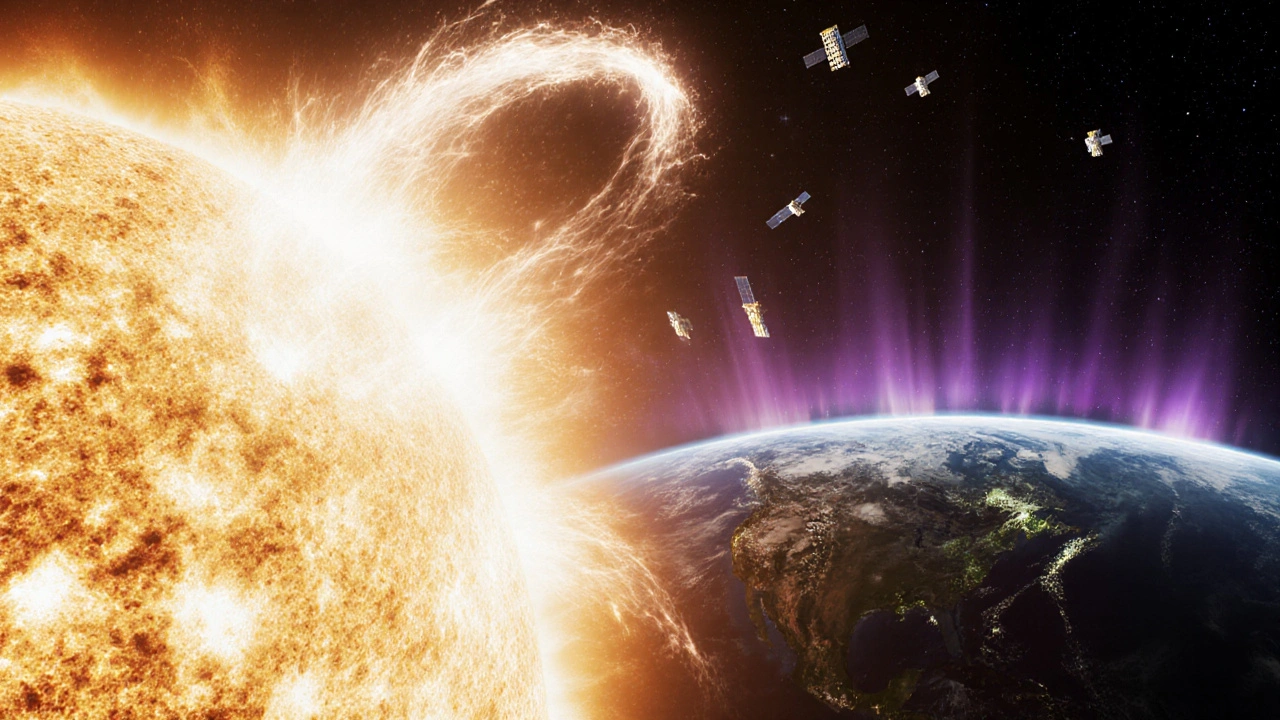When a solar flare explodes on the Sun, it doesn’t just light up the sky-it can knock out GPS, fry satellite electronics, and black out power grids on Earth. This isn’t science fiction. In 1989, a single geomagnetic storm caused a nine-hour blackout across Quebec, leaving six million people in the dark. Today, with over 7,000 active satellites orbiting Earth and global infrastructure relying on them for communication, navigation, and finance, space weather resilience isn’t optional-it’s essential.
What Space Weather Actually Does to Technology
Space weather isn’t just about pretty auroras. It’s a barrage of high-energy particles and magnetic disturbances from the Sun. The main threats are solar flares, coronal mass ejections (CMEs), and energetic proton events. These can trigger three major problems in space systems:- Single Event Effects (SEEs): High-energy particles punch through satellite electronics, flipping bits or frying circuits. A single proton can crash a satellite’s computer mid-mission.
- Geomagnetically Induced Currents (GICs): When CMEs hit Earth’s magnetic field, they induce electric currents in long conductors-like power lines, pipelines, and undersea cables. These currents overload transformers, causing fires or permanent damage.
- GNSS Disruption: GPS and other global navigation systems can lose accuracy or go completely offline during major storms. Research shows outages can last between one and three days, affecting aviation, shipping, and emergency response.
These aren’t rare events. NOAA estimates space weather causes over $1 billion in annual losses-mostly from satellite downtime, communication failures, and grid repairs. And with more satellites launching every year, the risk is only growing.
Engineering Resilience: Shielding, Redundancy, and Radiation-Tolerant Design
You can’t stop a solar storm. But you can design systems to survive it. Space engineers use three core strategies:- Radiation-hardened components: Instead of using off-the-shelf microchips, satellites use specially designed chips that resist ionizing radiation. These are more expensive-adding 15% to 25% to a satellite’s cost-but they’re the difference between a mission lasting 15 years or failing in 3.
- Redundancy: Critical systems have backups. If one computer fails due to a particle strike, another takes over. Some satellites even have triple-redundant navigation systems.
- Shielding: Satellites wrap sensitive electronics in layers of aluminum, tantalum, or even polyethylene. The International Space Station uses water tanks and storage containers as extra shielding for astronauts during solar events.
But it’s not just about hardware. Ground infrastructure needs protection too. Since 2003, the UK’s National Grid has used transformer design standards that reduce vulnerability to GICs. These upgrades have kept the grid stable during multiple storms, though experts warn regional differences mean some areas remain at higher risk.
Forecasting: From Hours to Minutes
Knowing a storm is coming gives you time to act. That’s why forecasting matters more than ever. For years, space weather models were slow. They had to run one after another, taking hours to produce a forecast. By the time the warning came, the storm was already hitting.In March 2025, the European Space Agency launched its new Space HPC supercomputer at ESRIN in Italy. This system changes everything. It can now run dozens of interconnected models simultaneously, cutting forecast times from hours to minutes. As Jorge Amaya, ESA’s Space Weather Modelling Coordinator, put it: “The computing power has always been a major bottleneck. Now we can deliver actionable data before the storm arrives.”
This isn’t just about speed. The ESA’s Virtual Space Weather Modelling Centre (VSWMC) links models from across Europe-tracking everything from solar wind speed to magnetic field orientation. This integrated approach gives a far more accurate picture than isolated forecasts.
Meanwhile, NASA and NOAA rely on real-time data from satellites like SOHO and DSCOVR, plus ground-based radio telescopes like CALLISTO. These detect solar radio bursts within minutes of an event-far faster than waiting for a CME to reach Earth.

Operational Protocols: What Happens When the Warning Sounds
Even the best-designed system can fail if no one knows what to do. Resilience isn’t just engineering-it’s procedure.When NASA detected a proton event in 2020, they didn’t just send an alert. They activated a protocol: astronauts on the ISS moved to shielded areas. Airlines rerouted flights away from polar routes where radiation exposure is highest. Power grid operators temporarily reduced load on vulnerable transformers.
Organizations need clear plans that don’t depend on tech that could fail during the storm. The UCL Organisational Resilience Report (2022) recommends:
- Having backup communication methods-like satellite phones or HF radios-that aren’t reliant on GPS or internet.
- Designating physical meeting points for emergency teams if digital systems go down.
- Training staff to recognize and respond to space weather alerts without waiting for automated systems.
These aren’t theoretical. They’ve been tested. In 2023, a major European satellite operator used ESA’s Space Weather Service Network dashboards to delay a critical maneuver during a predicted storm. The delay cost nothing-but avoided a potential mission failure.
What’s Next: The Future of Space Weather Defense
The tools we have today are better than ever, but the next decade will bring even bigger leaps:- ESA’s Vigil mission (launching in 2031) will position a satellite at the L5 Lagrange point, giving us a 4-5 day warning of solar storms heading toward Earth-like a weather satellite for space.
- D3S (Distributed Space Weather Sensor System) is being built to create a network of small satellites that monitor solar activity from multiple angles, improving accuracy.
- The SWE PDC (Space Weather Payload Data Centre), developed by Starion Group for ESA, will launch in late 2026. It’s cloud-native, zero-trust secure, and designed to handle data from hundreds of future missions.
The ultimate goal? A space weather forecast as reliable as your local weather app. Right now, we’re still in the 1950s of space weather prediction. But with the ESA Space HPC and new missions coming online, we’re moving fast.

Why This Matters to Everyone
You might think, “I don’t work in space. Why should I care?”Here’s the reality: every time you use GPS, check your phone, watch live TV, pay with a credit card, or get a power bill, you’re using systems vulnerable to space weather. A major storm could disrupt:
- Stock market trades timed to nanosecond precision
- Emergency response communications
- Flight schedules across the Atlantic
- Smart grid stability in major cities
Space weather resilience isn’t just for engineers and astronauts. It’s about keeping society running when the Sun decides to throw a tantrum.
Can a solar storm destroy all satellites?
No-not all satellites. Older, poorly shielded satellites are at high risk, especially those in high orbits like geosynchronous ones. Newer satellites built with radiation-hardened components and redundancy can survive even strong storms. But a major solar superstorm could disable dozens, if not hundreds, of satellites, especially if they’re not designed for resilience. The key is design: some satellites are built like tanks; others are like glass.
How do power grids protect against geomagnetic storms?
Power grids use special transformers designed to handle geomagnetically induced currents (GICs). Since 2003, National Grid in the UK and other operators have adopted standards that limit GIC flow by adding series capacitors and grounding controls. Grid operators also monitor real-time space weather alerts and can temporarily reduce load or isolate vulnerable sections. These steps don’t eliminate risk, but they prevent catastrophic failures.
Is there a way to predict exactly when a solar storm will hit Earth?
We can predict the likelihood and approximate timing, but not the exact moment. CMEs take 1-3 days to reach Earth, and their speed and direction can shift as they travel. New systems like ESA’s Space HPC and the future Vigil satellite will improve accuracy, giving us 4-5 days of warning with much higher precision. Right now, forecasts are good for 24-48 hours with 70-80% accuracy. We’re getting better, but we’re not there yet.
Can personal devices like phones or laptops be affected by space weather?
Not directly. Your phone or laptop won’t fry from a solar storm. But they rely on infrastructure that can be disrupted. If GPS satellites go down, your maps won’t work. If communication satellites are damaged, your internet or calls might fail. If the power grid trips, your charger won’t work. The threat isn’t to your device-it’s to the systems your device depends on.
Why isn’t everyone building space weather resilience into their satellites?
Cost and urgency. Hardening a satellite adds 15-25% to its price and increases development time. For small companies or experimental missions, that’s a big barrier. Many assume “it won’t happen to me.” But as space gets more crowded and our dependence on satellites grows, the cost of ignoring resilience will far exceed the cost of building it. More regulators are starting to require minimum standards-especially for critical infrastructure satellites.


14 Responses
So we're spending billions to protect satellites from the sun, but we can't fix potholes or fix the electric grid? Classic. We're building a spaceship while the basement floods. And no, I don't care how 'essential' it is. Priorities, people.
This is actually one of the most thoughtful pieces I've read on space weather. I especially appreciated the breakdown of GICs and how the UK grid adapted. It's rare to see engineering solutions explained with such clarity and humility. Thank you for writing this.
Radiation-hardened components? Yes. Redundancy? Absolutely. Shielding? Great. But let’s not forget: the real win here is the ESA’s Space HPC. This isn’t just an upgrade-it’s a paradigm shift. We’re moving from reactive to predictive. And that’s the difference between survival and dominance in space infrastructure. This is the future, and it’s already here.
In India, we don’t have many satellites, but we depend on them for weather forecasts, crop monitoring, and disaster alerts. This article reminded me how connected we all are. Even if you’re not in space, space is in your life. Thank you for explaining it so simply.
Wow. A whole article about space weather and not one mention of HAARP? Really? You’re telling me the sun is to blame and not secret military tech? I’m shocked. Truly.
I didn’t know space weather could mess with my phone’s GPS. That’s kind of scary. But also cool? Like, the sun is this giant force and we’re just trying to keep up. I’m glad people are working on it. We should all just be a little more aware, you know?
The part about airlines rerouting flights during proton events is critical. I fly transatlantic often. Knowing that crews are trained to respond to space weather alerts instead of just relying on automation gives me a lot more confidence. This isn’t sci-fi-it’s operational reality.
The systemic vulnerability here is staggering. We’ve built a hyperconnected, real-time, global infrastructure predicated on electromagnetic integrity, and yet our primary defense against solar disturbances is still a patchwork of legacy shielding, reactive protocols, and analog backups. We are running a distributed system with single points of failure that span continents, oceans, and orbits-and we’re treating it like a minor inconvenience. This isn’t resilience. This is roulette with the sun.
I’ve spent years in satellite operations. I’ve seen what a single proton can do to a $200M mission. This article? It’s not just informative-it’s a lifeline. The fact that we’re now forecasting storms in minutes instead of hours? That’s not progress. That’s salvation. I’m emotional reading this.
Interesting read. I think the real challenge is getting smaller operators to adopt these standards. Cost is real. But so is the risk. Maybe there’s a way to pool resources or create shared resilience frameworks?
The term 'space weather resilience' is technically accurate, but it's misleading. 'Resilience' implies recovery after damage. What we need is 'preemptive hardening.' Satellites aren't resilient-they're fortified. Grids aren't resilient-they're engineered. Language matters.
Wait… so the sun is just *suddenly* dangerous now? Funny how this all lines up with the rise of private space companies. Who really benefits from scaring people into funding space defense? And why is no one talking about the ionosphere being weaponized? The science is just a cover. You know what they say: 'Follow the money.'
Let’s be honest: this whole 'space weather resilience' narrative is just corporate propaganda to justify billion-dollar contracts for defense contractors and aerospace monopolies. The real problem? We’ve outsourced Earth’s critical infrastructure to private firms who don’t care about public safety-they care about profit margins. And now they’re selling us fear as a service. The sun didn’t create this crisis. Capitalism did.
Cool. Didn’t know satellites had armor. Makes sense.